Last week’s post on raising Monarch butterflies at home sparked a a slew of questions, comments and emails. I figured I’d better get back here and clarify a few things.
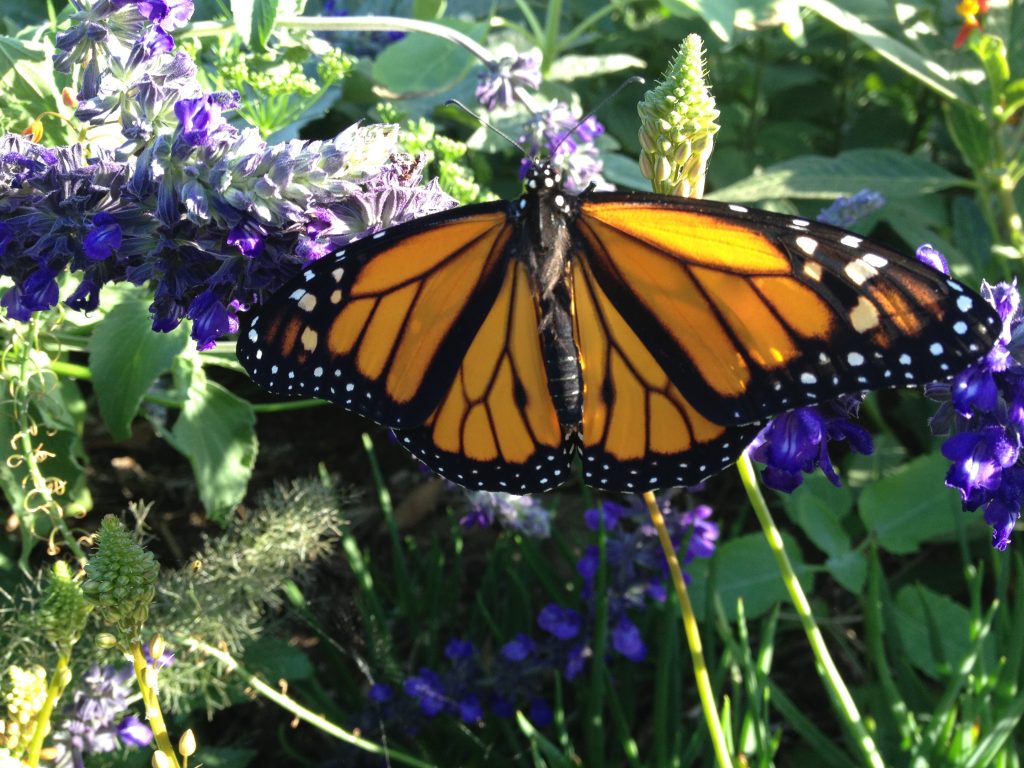
This newborn male Monarch hatched this week from my first “crop” of eggs. Off he went! Photo by Monika Maeckle
First, I left out the part about what to do with the egg, once you bring it inside.
I usually tear off the leaf that the egg is on and put it in a jar or plastic container with the lid on. This keeps it moist and at a stable temperature. Sometimes the leaves will start getting moldy or condensation will form on the sides of the jar or lid. If that happens, just open the container and let the fresh air in. You might even wipe off the condensation. Too much humidity may cause mold to grow and is not a good thing.
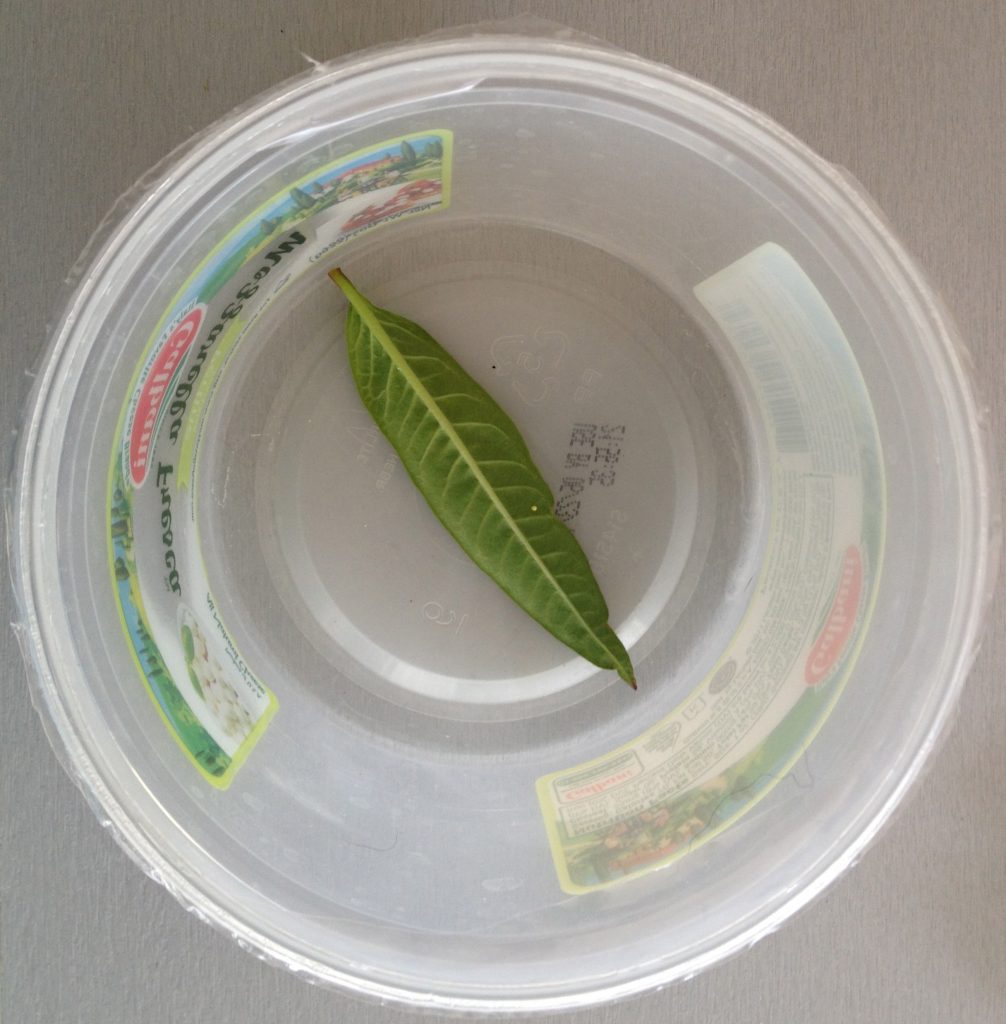
Put fresh Monarch butterfly egg inside a plastic container or jar with lid on. Photo by Monika Maeckle
But often as the torn leaves decay, they smell “ripe”–that is, you can tell they are starting to degrade. The eggs usually hatch within three – four days, so hopefully they will show themselves as tiny caterpillars before that happens. That said, it seems that caterpillars don’t mind that earthy aroma as much as we humans do.
Once the egg hatches, you can start the process discussed in last week’s post. There, I shared photos and info mostly about raising caterpillars in a vase-like setting with cut milkweed set in water and caterpillars munching happily on the leaves. But when you have LOTS of caterpillars, that’s hard to do.
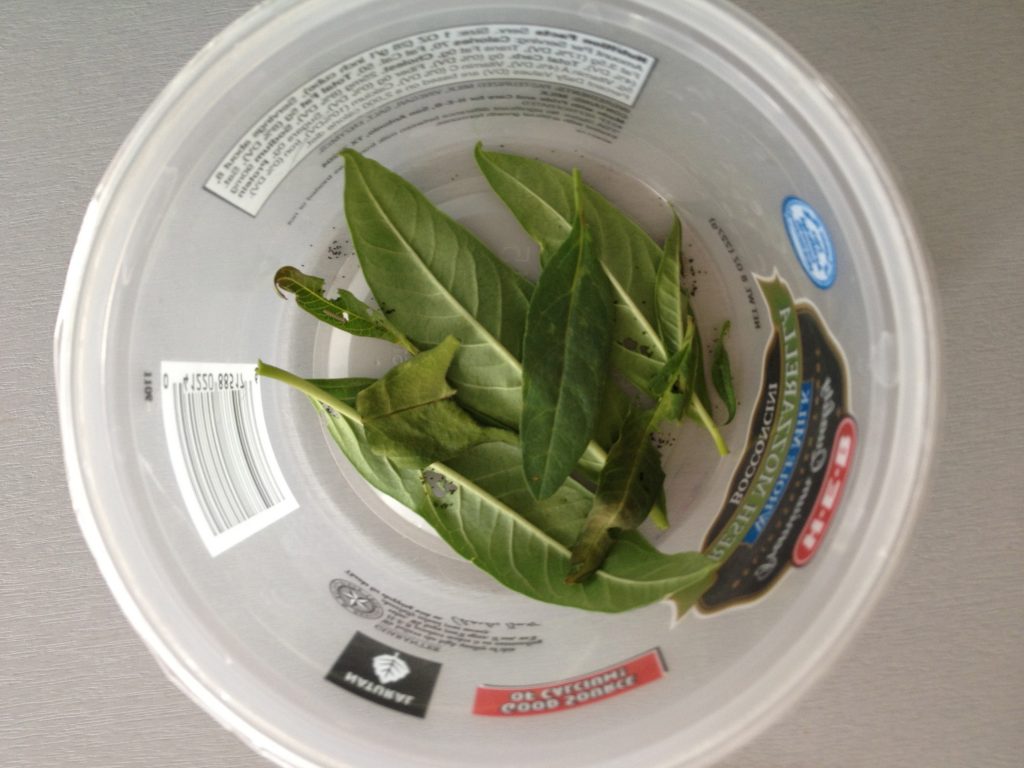
Seven baby Monarch caterpillars occupy this former cheese container. You can see one pretty clearly at 10 o’clock. Photo by Monika Maeckle
When I have more than two-three caterpillars at once, I use the contained “caterpillar condo” approach I alluded to but didn’t describe in detail last week. I will do that now.
I like to have a large stalk of milkweed that I place inside the container. Taking a small piece of dampened paper towel and wrapping it around the end of the milkweed helps keep it fresh and assists in extending its appeal to the caterpillars. Like us, caterpillars prefer fresh greens.
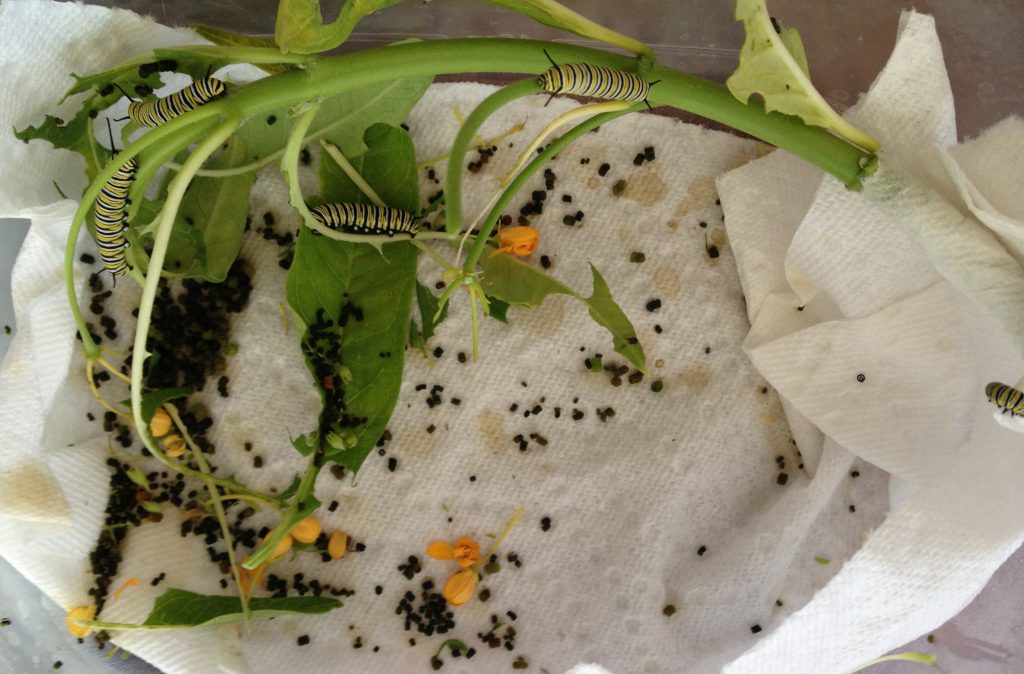
Paper towel on the bottom of the container helps in cleaning frass and changing milkweed. Note wet paper towel wrapped around stem on right side. Photo by Monika Maeckle
As the caterpillars get bigger and indulge in their 10-14-day feeding frenzy, massive amounts of caterpillar poop, or frass, result. The problem compounds with more caterpillars. When I have several caterpillars, a paper towel in the bottom of the plastic container helps to absorb dampness and makes for easy clean-up.
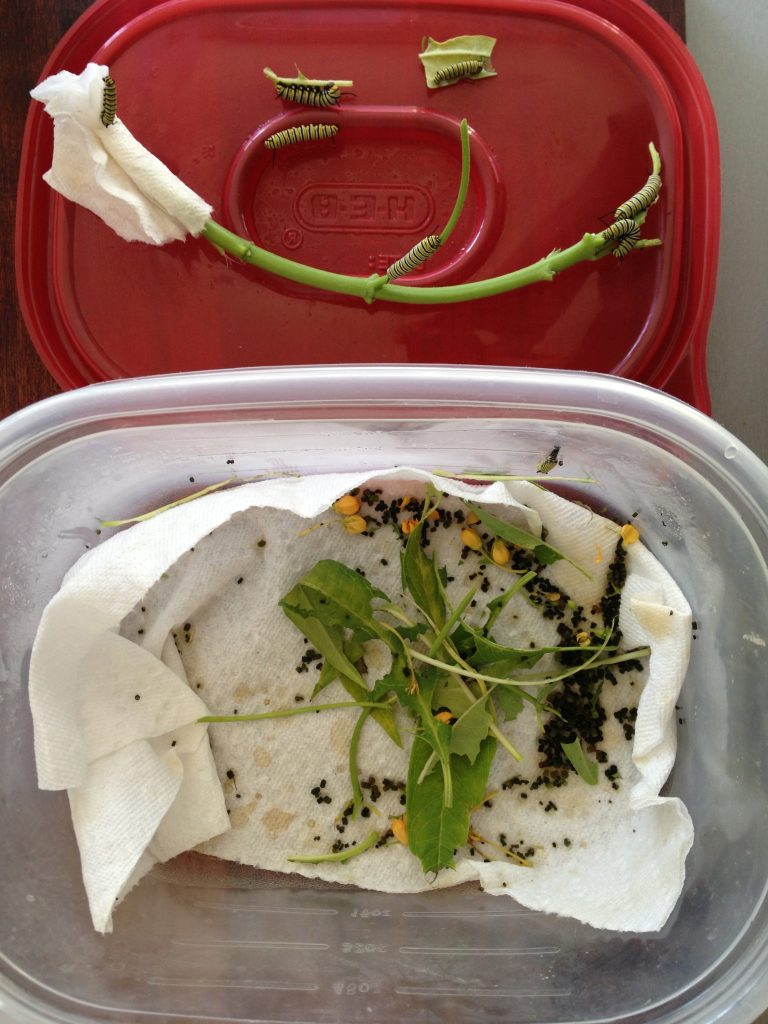
Just lift the stem and move the caterpillars out of the way while you clean the container. PHoto by Monika Maeckle
When the caterpillars reach their third instar, or stage, you’ll find you may need to supply fresh milkweed daily, sometimes more than once a day. Of course it depends on how many caterpillars you are raising. NOTE: When there’s nothing to eat, caterpillars can become cannibalistic. We don’t want that.
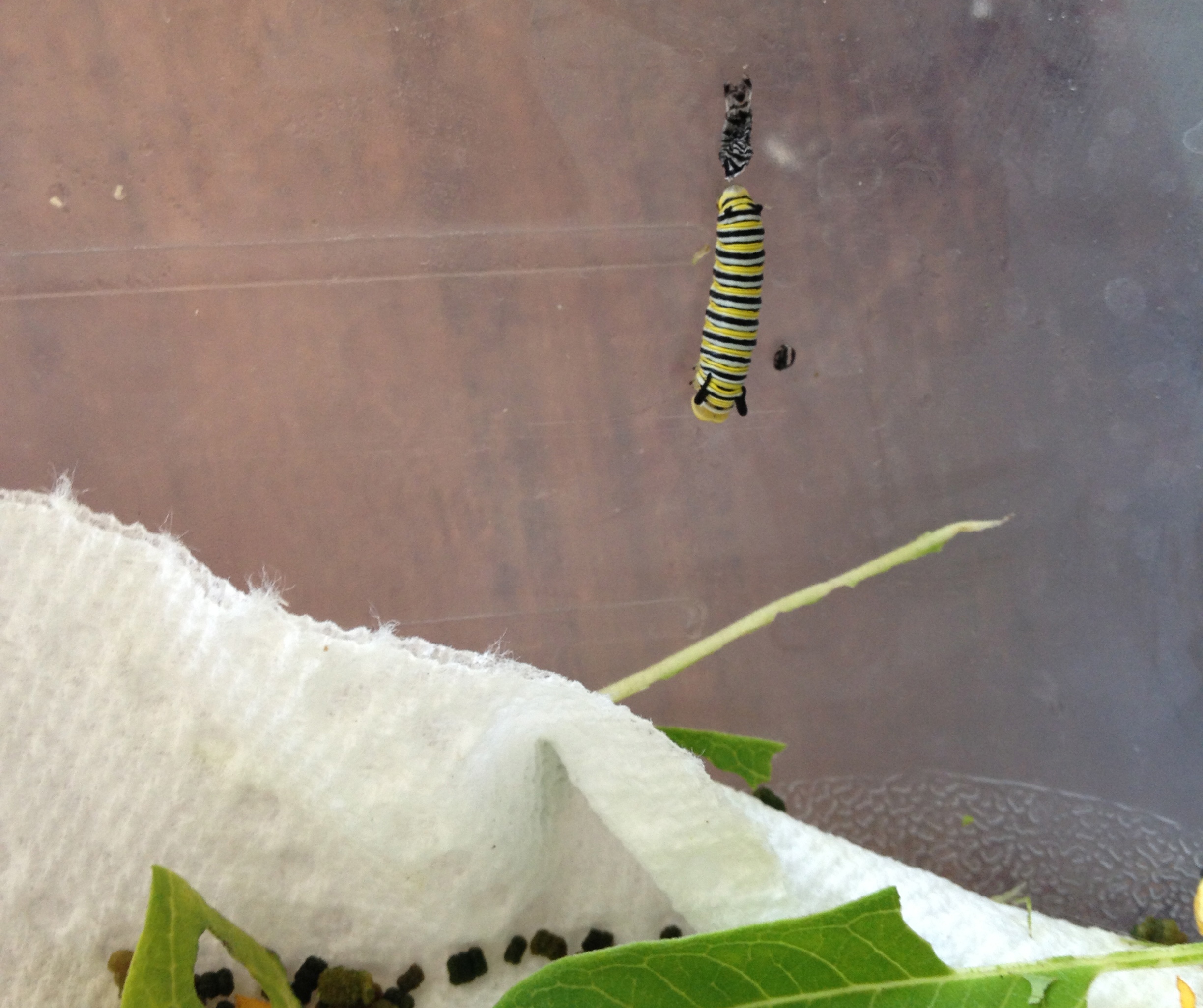
This Monarch caterpillar just shed its skin. Leave him alone to do his thing. Photo by Monika Maeckle
Some people may struggle with moving the caterpillars around. Often you can simply lift what remains of the stem and put the caterpillars aside while you wipe down the container. If a caterpillar is stuck in an inconvenient position, take a leaf and slide it under her. Usually she will climb right on, getting out of your way. I’ve used a spoon or paintbrush to move the caterpillars. Handling with your fingers should be discouraged. Usually they will ball up and drop to the ground and it can be difficult to get a grip on them.
Sometimes, the caterpillar is in the middle of shedding its skin and won’t want to move. In that case you should try to wait til the process is complete. Caterpillars seem to gravitate to the roof of the containers, too. I just let them hang out there while I clean up, then put the roof back on.
When it’s time to go chrysalis, I will move all these caterpillars to a chemical free milkweed plant. They will wander off and find a good place to transform themselves. As stated previously, I’m not squeamish about caterpillars in my house.
You can also put them inside the pop-up cages that I mentioned last week, and they will form a chrysalis on the side of the netting or the roof of the cage.
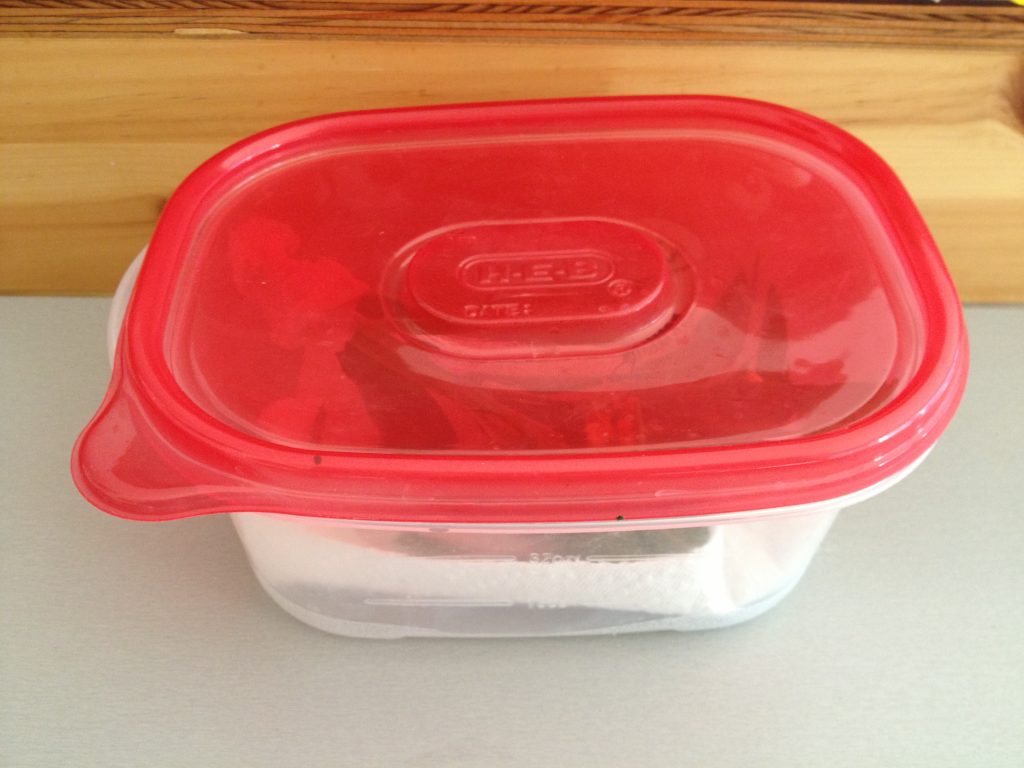
Put the lid on your caterpillar condo and wait til it’s time to go chrysalis. PHoto by Monika Maeckle
Good luck, and let us know how it goes!
For more information, check out the Monarch Larvae Monitoring Project page on raising Monarchs or Monarch Watch.
- FOS Monarch Lays Eggs in San Antonio Urban Garden
- Tropical Milkweed: To Plant it or Not is No Simple Question
- Oh Those Crazy Chrysalises: Caterpillars in Surprising Places
- Butterfly FAQ: Is it OK to Move a Chrysalis? Yes, and here’s how to do it
- Should You Bring in a Late Season Caterpillar into Your Home?
Like what you’re reading? Follow butterfly and native plant news at the Texas Butterfly Ranch. Sign up for email delivery in the righthand navigation bar of this page, like us on Facebook, or follow us on Twitter, @monikam. You can also read our stuff on the Rivard Report.

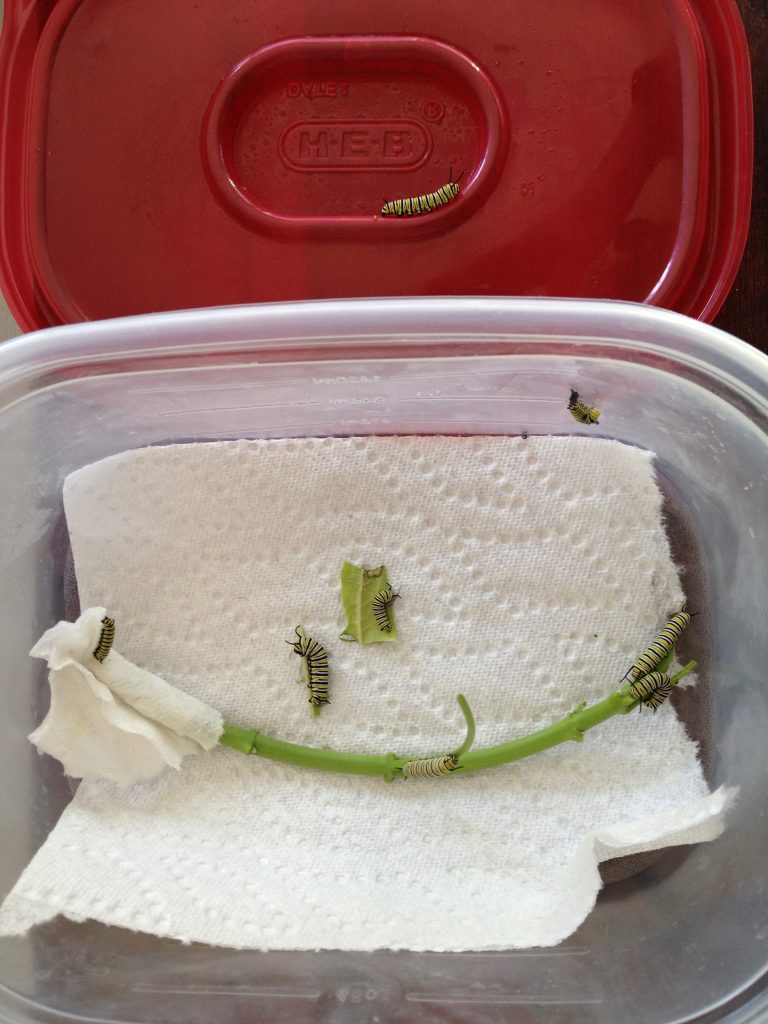
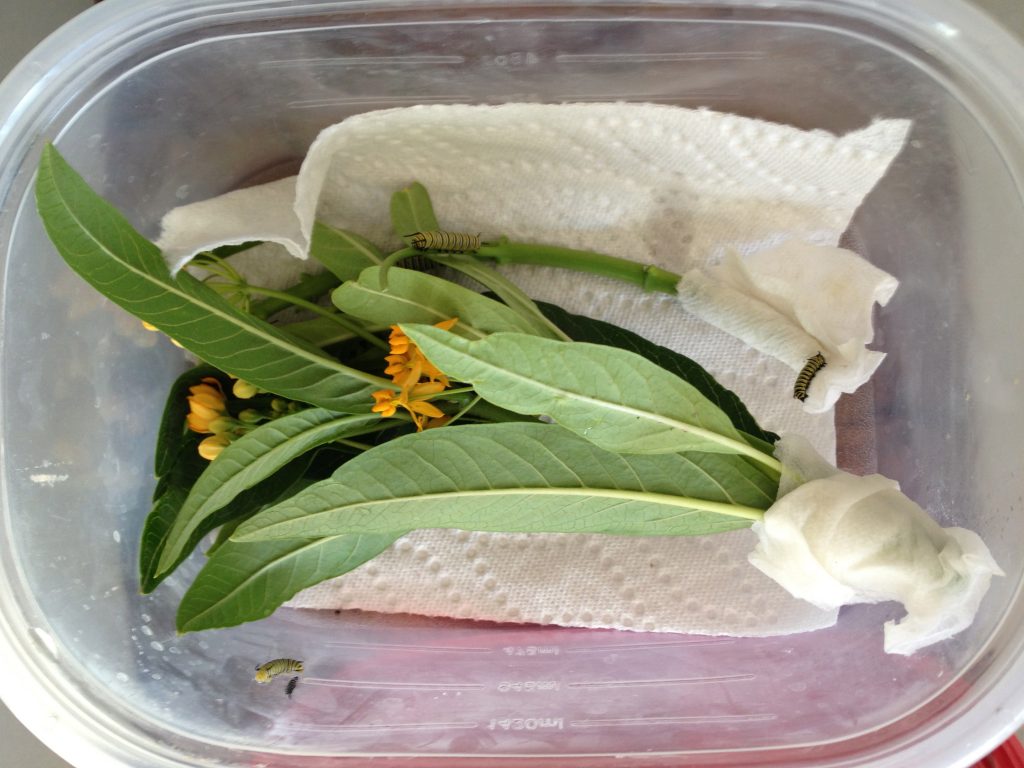
Everythig you suggest seems really good! Although I’ve had good results by taking cuttings of milkweed in a cup filled with water that I’ve covered with foil…or a to go coffee cup w/ the lid ( I slice little holes to put milkweed stems). I put paper towels under the glasses for the frass. I just change the paper towels. My milkweed cutting almost always root, so thats great for me in north central texas, I have plants for the future!
How do I know if it’s a girl or boy and do I put dirt in it’s home and when does it become a cristle and should I put it out side when it’s a cristle?
Mesh pop-up laundry hampers turned upside down over jars of leaves works best for me. Newspaper under the jars works well for catching frass. The caters climb to the top to make their chrysalises and are easily transported and monitored. If I am going to be gone for a day or two when it is time for them to emerge, I place jars of fresh flowers inside. Here in NC I don’t have any milkweed emerging yet. Can’t wait!
I live in Southern California and have been raising monarchs for over a year. I have lots of milkweed in my yard, and I collect eggs
by removing the leaf with an egg and placing it in a casserole dish with wet paper towels beneath the leaves. When they hatch, I put them outside in a large screened cage wih 4 large milkweed plants. I make sure the plants are organic –
try to purchase milkweed at a local nursery rather than a chair.
i live in upstate ny and have been following the monarchs progress through your posts and journey north. i am having a hard time finding live milkweed plants for sale, the only place that i have found that will ship now is educational science.com for 10.00. my cats are stage two i believe. im thinking that since they got stuck in Texas you guys might be running scarce on milkweed.
I you send me your address I will send you seeds! I have red, orange and showy milkweed!
I ve just watched 3D IMAX “flight of the butterflies” and would like to grow a patch of milk weeds for monarch butterflies. If you could share the variety of milk weed seeds that you have, I would appreciate very much.
Hi! Any chance I can buy some seeds from you too? I have 2 nice orange plants and just found my first caterpillars on them, but want to create a haven for them next year!
Please email me and let me know!
Thanks – and have a great day!
Maria
Hi Maria,
I don’t sell seeds, but you can try Native American Seed at http://www.seedsource.com. Good luck!
It looks like the lids of your containers don’t have any holes….is that correct?
My heart was broken last year when my precious caterpillars did not emerge from their crystallis and fell to the floor and died. Can you talk about diseases that have plagued my beloved Monarchs and how to prevent this from happening again this year? My Milkweed is growing like crazy but it is still rainy and cold in Oregon so no butterflies yet. But I do not want to repeat what happened last year. Out of 12 cats only 1 was released.
Rene there are so many disease and obstacles–that’s a whole other blog post I hope to get to at some point. Check out Monarch Watch’s sight or the Monarch Larvae Monarch Monitoring Project site–they detail parasites, predators and other challenges.
I had bought emergency milkweed plant at a hole in the wall plant store and had left the Lowe’s milkweed plants outside which were the good plants…..well to make story short I had 15 caterpillars in a ventilated cage with my emergency milkweed plants that I bought at a hole in a wall plant store! I was so depressed all my caterpillars died!!!!!????
I had to buy an emergency supply at a local store. Brought it home and put in flower bed by my naked milkweed stalks. My cats transferŕed and promptly died. Apparently the grower had sprayed them with something.
The moral of the story is to thoroughly wash and allow the plant to air dry before you use an emergency supply of tropical milkweed. Between this event and the predator wasps it was a hard spring.
Thanks!!! I thought it was the most HORRIBLE THING EVER THAT I WENT BACK TO THAT NURSERY AND SHOWED THEM MY DEAD CATERPILLARS AND GOT MY MONEY BACK FOR THOSE HORRIBLE PLANTS!
I tried… went to the nursery and told them they’d murdered Monarch butterflies. I got a blank look and finally the manager said if we don’t spray them, the caterpillars eat them. We are here to sell plants, not feed bugs. I haven’t been back.
It sounds like your plant was sprayed. A lot of growers consider milkweed an ornamental plant and spray away. I avoid chain stores,
and stick with local, known,
Environmentally conscious
Nurseries for my milkweed.
We cut stems of milkweed and IMMEDIATELY place them in a rinsed- out soda can. Works great, no torn foil.
How do I prevent birds from eating the cats and butterflies in my back yard?
Get one of those fake owls that moves its head? I guess you could also try netting, but the bird predation is all part of the cycle. MM
Netting will prevent birds and reduce wasp parasites.
Yes, unfortunately, Nature is cruel.
awesome i will make 1 and see it grow! BUT i only have 4 in my garden so if i raise 4 wouldn’t that make even more poop? anyway do i need a bigger box or a smaller box? i am only 9 and i really want to keep a caterpillar! :{D
Yep, four caterpillars will make more grass. One of those salad containers from your local grocery store should work fine. Good luck!
Oh and where do i get milkweed from? X X
M
You should be able to get some milkweed from a local nursery. Make sure it’s free of any pesticides, though. Good luck!
I have half acre of prairie plants, including milkweed, managed organically. I can raise caterpillars on tented plants. But where we are normally a monarch feeding and nursery hotspot, I have not seen ONE this year. Is there a way for me to obtain eggs or caterpillars for raising and repopulation?
Kit, you can order eggs, caterpillars and butterflies from professional butterfly breeders. Try http://www.butterflybreeders.org.
Where are you?
Hi Mickey,
I am northeast of the great lawn wasteland known as New Albany, Ohio. Last year, after I wrote the above post, I went to an organic business and bought four A incarnata plants. They were potted, and were about 4 ft tall. I selected plants with eggs, and raised the resulting 6 caterpillars to adult successfully. Very late in the season, I saw one male, who came in and mated with one of my released females. She laid an egg before leaving. That caterpillar was also raised and was released in mid October!
For some reason, we are not seeing Monarchs here, despite a quarter acre of habitat, which has been here 15 years. In past years, up until 2013, we had around 20 Monarchs a day in late summer.
I also went to the only area nursery that carries the plants. $55 later I owned 3 that are just under 3 feet tall and very leafy.they came home with another caterpillar and several eggs since there was a cloud of Monarchs fluttering around them. The next night out temperatures dropped and we had unpredicted 25 mph winds dropping our wind chill to low 30s. Despite everything I could do to rescue them I lost the 4 smallest ones to hypothermia. The rest are merrily munching away although I can only find 4…..I have learned they tend to move to lower plants when the wind is high. Will go do census after wind does around noon!
This is only slightly less effort than is required to tend my entire garde n…..But it’s all worth it. I’m seeing about 3 Monarchs a day so suspect they are still migrating thru.
Hi There Monika Maeckle,
Interesting Post, I live in Beaumont, Tx and was wanting to start catching and raising caterpillars, but have not had any luck in finding them anywhere. I got online to see about ordering The monarch caterpillars, but they can’t be shipped to Texas because of USDA. Why I don’t know maybe it was just that website, but still I don’t want to have to pay for something I am later going to release. Is there certain places to look for caterpillars? We have caught one, and he has already made his little cacoon. It’s been about 8 days so hopefully in the next week we will see if we got a butterfly or a moth. Please any info would be great. I have a 3 year old daughter that is interested in this as well. Everytime we are outside she is looking for caterpillars..
Keep up the posts!
It’s pretty tough to find Monarch caterpillars this year. You might want to order some from an authorized breeder–check out the International Butterfly Breedes Assn at http://www.butterflybreedrs.org.
Your chrysalis should be hatching soon. Just watch for it to turn opaque, then dark, then, clear. When you see the orange and black wings through the cell, you know it’s hatching soon. Give it a few hours to harden up it’s wings, the let her go on her way to Mexico. Good luck! PS There’s several post on my site about raising Monarchs at home. Just do a search in the search box for more info. MM
Monica,
My Monarch emerged about 8:00 a.m. today and seems to be taking a long time to get moving–just hangs from the top of the mesh cage. It’s now 5 hours later. Could there be anything wrong? It’s a quite large female.
Hmm. Is it dark? Often times if its cool or dark, they will just hang for a day. Butterfly breeders tell me that they don’t have to eat the first day. If she looks healthy just wait til tomorrow and typically they will fly to the light–a window or somewhere. You can take the cage outside and if the weather is sunny, she should fly off. Let me know how it goes, and good luck!
Thanks Monica. I’m placing the cage by the patio door now.
I am in the Santa Fe, Texas area. If I have as many monarchs and eggs and cats next spring, I can spare some to people who want to try to raise them indoors and won’t have to fight to protect them against the wasps. Would love for more of them to survive
Micky, I live in Santa Fe and have 19 chrysalis, 9 are outside, and 3 butterflies. I had 3 milkweed plants that stayed loaded with cats until they had all been eaten about 2 weeks ago. Please reply if you have had good luck keeping them healthy until they can be released.
Thank you so much for the notes with the pictures. Very helpful!
While at my nursery picking up plants I added milkweed for my yard knowing that Monarchs needed this for their caterpillars. I had no intentions of trying to raise butterflies.
Unbelievably (because I don’t have many butterflies of any kind in my yard), the day after planting the milkweed, I watched as a Monarch landed on each of the three milkweeds I had bought and laid an egg on each one! Then I was curious as to how long the cycle was from egg to butterfly and found that unless I brought them inside, they were not likely to survive. And, now yesterday all three eggs hatched to 1 instar cats!
Keeping the milkeweed from drying out has been my biggest issue. These guys are so tiny and I don’t want to disturb them. . . I just bought a florists tube at the grocery store for . 25 cents and put a stem in that and seems to have done the trick!
Thanks again for taking the time to publish all this!
Hello,
Thank you for all this information — it is very helpful. I have a question. You wrote:
“When it’s time to go chrysalis, I will move all these caterpillars to a chemical free milkweed plant. They will wander off and find a good place to transform themselves.
You can also put them inside the pop-up cages that I mentioned last week, and they will form a chrysalis on the side of the netting or the roof of the cage.”
OK, if you don’t have potted milkweed plants, and are using cut sprigs, can you just lay some fresh springs inside the cage? And how will you know when it’s time to put them in the cage?
The caterpillars will get quite large and turgid, as if they are about to bust. They will stop eating and you will wonder why–they are going to spin the silk button to support their weight. Also, you’ll know that it’s about 10 days. They like to hang from their j-shape so I try to have some vertical sticks for them to do that. I have never seen them form the chrysalis on a plant laying flat on the ground–that would leave them vulnerable. Think like a caterpillar: where would be a safe place to hang upside down safely? Good luck!
Has anyone ever reared monarchs (mated a pair) in a smaller netting?
I would like to keep this hobby simple and not have to go out and look for
Eggs all the time or have to pay for them.I know of individuals that rear them in really big mesh nets…Im just trying to keep it simple here.
Any advice would help.
M. MDave
I have seen Monarchs being raised in net tents that are supported on tomato cages. The milkweed plant is potted. The tomato cage is placed around the plant, upside down. The legs of the cage are bent inwards so they form a flat “roof”.
Tnx a million…..I like that idea….now the next question is…can they possibly mate in this net with a few nectar plants and of course some milkweed for them to lay eggs on if possible. Again I’m just trying to keep this somewhat simple as I live in a suburban area with not a big backyard. ….PS…also retired so got a bit of time on my hands…tnx again for the quick response. I have a dozen cats growing now and have 2 laundry nets from bed bath and beyond want to really do this but at same time KISS….keepin it simple….
I’m afraid I don’t know the minimum size cage for breeding the adults… maybe someone else on the forum will answer.
Beth, I bought one milkweed plant,at the end of May, this year, planted it in a pot. A monarch laid about 20 eggs. I noticed that the wasps were getting the instars so I netted the plants. Put bamboo sticks all in the plant and the netting was clipped to it. Ended up with 14 huge caterpillars. 9 Chrysalised and 5, 3 males and 2 female Monarchs were released. I live in Texas so due to the heat the times from egg to chrysalis were faster. I am thrilled. I am now working on my second batch. I have three caterpillars. I put a spider lily plant that is also in a pot next to the their milkweed and they seem to like to chrysalis on this since it has wide thick leaves. Last night two are now in there J position and I expect the third caterpillar to do that today. I love the netting the plants together, the only problem I have is that a couple get out from the net and I never find them, but without the net the lizards or wasps will get them all. I put the pot in mostly shade, on edge of my pario and make sure the pot is watered for I have noticed that they stop eating if the pot isn’t watered. we’ve had temps into the hundreds this past week, now in 90’s. Once they come out as butterflies, I cut the plant stems back, put the pot back out into the sun and let the cut stems heal a couple of days and stick them in dirt and I have a new pot of milkweed. Since I live in the South I am growing tropical milkweed, which according to our Butterfly center is completely acceptable.Beautiful plant and many butterflies use it for nectar. Raising the monarchs has been a wonderful experience. I’ve seen all 5 instars, seen them as they chrysalis and come out as butterflies. Raising them on my patio with the host plant and a plant they like to chrysalis on to me is so much easier than all the work of keeping them indoors. Their frass can be easily washed away with the hose. My duties are to check often to make sure that they don’t get on the netting and when they do I takje a cut milkweed leaf and they climb on it and I put them back on the plant. If they are off the plant and its about time for them to wonder off I will put them on the spider lily plant right next to it. They will wonder all over it till they find just the right place. I make sure that they don’t fall and wonder off the plant. Can’t always be there so I usually lose one. Don’t know what happens but again I find that raising them outside is less work in the long run much easier for me. I’m just amazed, and all due to my buying one plant this last May. What joy I’ve had ever since.
2 questions
1..How long does it take after a full grown female is mated by a male to drop
Eggs?????
2. has anyone brought eggs to full monarchs and then mate them in a smaller mesh net.???? Is this possible or do you need a HUGE flight cage
To have them mate. I am tryingto keep this simple where I can have eggs without looking for them or buying them.
See my reply to Dave Jackson, above.
Dave,
It makes me feel sad to think of adult butterflies of any species trapped in a netted area. I do think the adults have evolved to want to fly freely. I can’t imagine them being happy in confinement, and they–like many other creatures–would probably have a hard time mating in a constricted environment.
I don’t spend any time looking for eggs. When I see a young caterpillar on a milkweed leaf outside, I bring it inside on its leaf and add it to my “nursery.” It’s no work at all, since I’m out in my garden a lot, just looking things over. I think it’s definitely simple.
Hi Ruth
Well I paid 20 dollars for 12 eggs..
2 made it to cats..called the guy and He have me 12 cats to makeup for it.I can’t see paying for cats or eggs provided buy Mother Nature. Soooooo I want to raise these 12 cats to maturity..Then if they do mate in short order I will have FREE EGGS! At that point I will release ALL monarchs..if they don’t mate and lay eggs in 4 or 5 days I will release them and that’s along astheynshould be in the net..I looked hi and low for eggs and cats here in western ny….no luck..but…..I’m not paying 20 dollars everytime I want to help these little guys out…trust me they will not be harmed..”
Well, good luck with your cats, Dave. If you have your own milkweed stand, the monarchs will come to you. I planted a stand 3 summers ago, and it’s just filling out now. The monarchs were sparse at first (like the plants) but this year the stand has been filled with them. I just started a new one in another section of the garden.
Hi Ruth,
Where are you located?
I am in central Ohio. I have a HUGE number of milkweed plants on my acre and a half, but no orange visitors. I have seen seven Monarchs in Ohio now, but none on my property. That compares to sightings of a few years ago numbering in the 20’s PER DAY.
I hope your statement to Dave that “if you have stands of milkweed, they will come” is true. So far, in the last two years, we have not had much luck.
Our half acre of prairie is visited by various butterflies, but no monarchs. Still, I keep watching all my plants, hoping…
I am entertaining the exact same idea as Dave’s. Next summer I hope to purchase some cats from a farm, and raise them here. I hope to be able to build a 6 x 6 x 6 cube covered with net, and place it over a 6 x 6 plot planted with food plants for the adults and for egg laying purposes, then hope they will grace me with some eggs. After that, the adults would be released, of course.
KIT
Very interesting Kit as of today I have seen
Only 7 monarchs also.Thats why I broke down and bought cats…still can’t believe I did that
But I want to help them some how.Lets hope
They come back next year a lot stronger then weve seen this year.Thats also why I hope
I can rear them in a good size mesh net.Time
Will tell.
Dave,
Here is the enclosure I am thinking of building in my butterfly garden.
http://www.petclassics.com/Cat-Enclosures/small-cat-kitten-enclosures.82.html
Cover with screen, not wire, of course.
I have four big stands of milkweed on my property, which includes three different species (one is endangered). Our half acre prairie includes many nectar sources as well.
Here we have a huge problem with parasitic wasps. Nearly every American silk moth cat that I have tried to keep, has made it to the final instar, only to break out in wasp pupae. They nauseate me!
I fear something similar for the Monarch cats, which we cannot afford to lose at high number when the population is so low.
Let me know how your cats do!
KIT
That’s good kit..just to let you know I live just outside of buffalo ny..the guy I got my cats from runs eastern monarch society..GREAT GUY?!! He has a 20 x30 foot mesh cage!!!!! Unreal!! I just don’t have room for that and like I said I want to keep this simple. I’m trying a 4foot x 4foot mesh to start…Stay Tuned…….also have a TON of common milkweed here but…..DOG GONE IT ZERO EGGS…
Hi Kit
1more question don’t know if you know the answer.After the male mates the females can she drop her eggs at anytime or does it take a week or so before she lays them on milkweed?…..curious
Hey Dave,
I do not know the timing between mating and egg laying in the Monarch, but I bet the guy you got your cats from will know!
KIT
Hi Kit…
They can lay eggs right after she gets mated……
Kit,
I’m in Duluth, MN. I had milkweed last summer too, but hardly any monarchs then — still, there were some cats and eggs. Some summers I see more than others.
Even with healthy wildlife populations (non-endangered, I mean) it’s normal to have population swings. We’re having a particularly good year here for monarchs, but not every summer is like that.
It’s hard to know, during a year with low numbers, whether that’s part of a normal swing or if it’s because of the population stress on the species. Or maybe both.
Monika did post a blog this summer which, if I remember correctly, said that they were predicting an extra good year for the upper midwest, and I am noticing a lot more than usual.
By chemical-free milkweed, do you mean milkweed that hasn’t been sprayed with any pesticides? Or is that a specific plant?
I think that means no pesticides, no lawn weed control products, and the like. We manage our half acre prairie totally organic, but we do make very very limited use of chemicals for gardening – and only when we have a big pest outbreak in our garden plants.
KIT
I noticed above the container with the red top does not have air holes. I’ve been afraid to use a container like this but my tiny babies keep escaping from the containers I have. How much air does larva need?
Not sure scientifically. However anecdotally, I use jars with the lid loosely on for very small caterpillars since it’s so hard to see them and they escape easily. They seem to do fine with the air in the jar. That has been my experience.
Thank you very much for your prompt reply and for this website!
Hi Monika,
I live in Columbus, OH. I am first time Monarch mom that ordered 20 eggs (I actually recieved a few more than 20 on one tiny plant). They hatched on August 17th. So far all have survived and most of them started pupating last night. Over half of them climbed to the top of their enclosure, however, several of the remaining ones have attached themselves to the butterfly weed bouquets I have been feeding them..These bouquets will not last for more than a couple days as they are cut from my larger plants and then put in bottles of water that I have been changing daily. What can I do with these chrysalises when the cut plant wilts? I am very concerned for them and afraid to touch the enclosure and disturb them as well as the others attached to the top as I realize they are in a very delicate stage for several days.
Also, on the day that my cat eggs arrived, I walked out my front door to the most beautiful monarch butterfly drinking nectar from my two giant first year butterfly weeds and depositing eggs all over my plants. Sadly, about a week later all eggs had vanished. But to my surprise yesterday, while collecting cuttings for my mail order cats, I found three baby cats. I promptly brought them inside and put them in their own enclosure in hopes that I can safely rear them to adulthood. I keep removing huge Chinese praying mantises from my butterfly weed daily that sit around waiting for all the little flying pollinators that visit it.every day. I feared it was just a matter-of-time until one of these mantises caught and killed the cats.. .
HI Toni,
Please goto my Facebook page and see the cover photo. It is a picture of dried, wilted milkweed with many chrysalises attached. I think you might be fine with the old milkweed as a place have the chrysalises hang. Take them out of the water so they don’t rot, and let them firm up. You can stick them in a dry vase as I do. If that doesn’t work, you can removed the chrysalises and attach them with a pin or tape by gathering the silky material they spin to attach themselves. Or tie dental floss around the end of that material and move them to a stick or other plant. The important thing is to make sure the chrysalis hangs vertically and they have something to climb up to–even if it is just the empty shell.
As for the eggs disappearing, yes, that is what happens. That’s why I like to bring them in the house. Some research has shown that left to nature, the eggs have only a 10% of completing the life cycle (maybe that’s why butterflies lay hundreds of eggs). When we offer assistance and bring them inside, the odds are reversed and they have a 90% change of making it. Good luck, and thanks for writing! –MM
Thank you so much for you speedy reply, Monika. I did exactly as you said with the milkweed and it is going to work fine. I found 5 more cats on my milkweed outside (and a sixth one that a praying mantis had) and put those with the other three. I am thrilled to have 8 babies from the mother monarch that visited my milkweed. I just wish I had been able to save more from the predators. I am keeping my fingers crossed that the cats that I brought in from my plants don’t have any parasites. I had a male monarch show-up at my plant today! I am so happy that I planted milkweed this summer. I can’t wait to raise more monarchs next summer.
Great, glad to hear it. Watch out, you’ll become addicted.
Hello again Monika! I have a dilemma and quesstions with my final 10 chrysalises that should become monarch butterflies over the next 1 – 4 days (I have released 19 over the past 5 days.). The next
two days in Columbus, OH are going to be in the high 70s with lows in the 50s but unfortunately with rain predicted. Then the following 4 – 5 days are to be partly sunny but much with lower temps. with highs in the 60s in the day and low 50s at night. I hate to keep them in their habitat for longer than absolutely necessary. What should I do about releasing my young monarchs during this early fall-like weather.
I also forgot to mention that I leave for work too early to release them and I arrive home around 4pm (it gets dark around 8pm). so I have a very small daily window to release them. If they emerge on the weekend I can release them around 10am before I go to work.
Thank you for all your help!.
Hi Toni!
I have lost your email. If you don’t mind, send me another, and now that my new computer is working, I will be able to save it and not lose it in another crash!
Next spring, I plan to start seeds in pots and also a 100 x 100 foot milkweed garden, so if you are still very active in rearing monarch cats, I may be able to supply you.
KIT
Hi Toni! I am excited to hear you are in Columbus! I am in Johnstown, just ten minutes from downtown New Albany! I would love to have someone local to correspond with in the journey to help Monarchs. You can email me at turkishangoracats@earthlink.net
Regards!
Kit Goodwin
New Albany Schools
I sent you an email, Kit.
Well… I have spent the summer watching for adults and cats. I have seen somewhere around ten adults all summer, in a nectar and milkweed rich environment where we used to see that many in a day. I have watched eight cats on their food plants, with strong evidence that at least six were lost to predators. In two cases, the predators were actually caught in the act. Surprising was the fact that these two predators were hymenoptera… one soldier bug and one milkweed bug.
The other four were suspected to be birds.
Now, having this many losses, I have finally brought in a cat for raising indoors. Will air conditioning cause a problem? Our bedroom ranges from 72 to 76 F.
The current cat is about 1/2 inch in length. Any idea from size, what instar this is likely to be?
KIT
I don’t think AC is a problem, unless it’s extreme. Yours is probably 1st or second instar. Check out this link at Monarch Lab for more detail:http://www.monarchlab.org/Lab/Biology/MonarchLifeCycle/Larva.aspx. Good luck!
I have a general question. Do the caterpillars spin silk when they are shedding between instars?
have two monarch cats that did not attach themselves to the dead tree branch I provided indoors? the first one spent five hours trying before I went to bed…next morning was on the paper towel lethargic but still alive…the second one now is wandering about on the coffee table but not attaching? all the web posts make it sound so easy???
I have found eggs for the 1st time. I saw a monarch female laying eggs so I brought some inside. It’s been almost 6 days and they haven’t hatched, neither have the ones still out on the milkweed. Are they sterile?
Thanks!
This is my first time growing monarchs. I built a cage and put a milkweed plant inside. Since I live in a apartment with very little light I had to place a grow light above the cage so my plant won’t die. I bought 3 chrysalis and once they hatched I put them in the cage so they would lay some eggs and I can let them go. My issue is that I’ve found the Monarchs to stare- a lot- at that bright light and it worries me that it’s bad for them but I haven’t found anything stating that it is…. Also, They were drinking the nectar from the flowers but they’re all gone now so I have sugar water in there that they drink now. Is that nutritious enough?
Hi,
Our caterpillars are doing great for our 4th grade classroom. They are eating a lot and they are a little over an inch long; however, I noticed that last night (early evening), they are just immobile and sitting still on a leaf and not moving. This morning. I noticed the same thing….. I was wondering if something is wrong .
I have the same situation going on with my caterpillars. I’m following to see if anyone has an answer for lethargic caterpillars.
Hi I am really new at this, can I use wild milkweed?
What can I do I have six caterpillars on my milkweed but im afraid to leave them alone in the garden what can I do????
Living in Florida we’re lucky enough to have a pool cage / lanai, so we can raise milkweeds protected in pots “unmolested”. Last year we encouraged monarchs naturally by growing milkweed outside, but only found three chrysalis in total, experienced LOTS of dead caterpillars, and the milkweed struggled to keep enough foliage for the relentless waves of caterpillars that never seemed to make it all the way through to becoming to a butterfly. We easily had over 100 caterpillars but only three butterflies emerge.
This year we’ve been keeping the milkweed inside the pool cage protected – and then I move one or two plants outside literally for 1 or 2 days. That’s all it takes for the local monarchs to show up and lay their eggs, and then I move the plants back into the pool cage. Three milkweed bushes just supported 13 caterpillars to chrysalis (we didn’t lose any), and I’ve just transferred 12 of those chrysalis into butterfly cages at the two schools my children attend for classroom education and release. The 13th chrysalis I’ve left in-situ in the pool cage as it just doesn’t look quite right. I’ve just rotated my plants and put fresh ones outside, and already have new caterpillars less than 1/4″ long on the fresh plants, while the other plants are segregated, caterpillar free, and get a chance to grow new foliage.
Hopefully this rotation schedule works out!
I have to raise outside. I have tons of milkweed and have been watching Monarchs laying eggs for the last two weeks. Regrettably I can’t move them to cages or rotate plants in and out secondary to mobility issues. I’m hoping for better luck this time around. Predator wasps got about 2/3 of my spring caterpillars.
I’ve just begun raising these beauties and I have been placing the potted plants directly into the cages. I must have about 25 caterpillars in there, so I’ve been replacing the plants every couple of days (getting expensive, but that’s ok – I’ll just plant these stripped ones into my garden.) This morning, I noticed a chrysalis had fallen to the floor of the cage. Is there any way to help this butterfly or is it done? Thanks.
You can try glue or tape to reattach the chrysalis in a way that most resembles nature. They can also emerge on the ground, but they need a net or stick near to claim up so their wings can drop and form properly with the help of gravity. Try this link: https://texasbutterflyranch.com/2011/07/31/butterfly-faq-is-relocating-a-monarch-chrysalis-ok-yes-and-heres-tips-on-how-to-handle-them-with-care/
Hi, Thanks for providing these very informative articles. I’m waiting for our small cage, cube, 15″ X 15″ … A local nursery carries several varieties of asclepias. I’m very excited about this since our seeds did not grow. I have a few questions, however: 1/ How often do you clean the cage; once a week .. or as often as needed? I can be neurotic, so I don’t want to disturb the “cats” every hour on the hour if I see 2 tablespoons of frass. 2/ I assume they get the water/moisture they need from the leaves, is this correct? 3/ After they are raised and ready to fly, should I take however many to the host plant in the yard (even though it will be newly planted at that time) or should I set out a shallow container of fruit slices such as apple? 4/ The cage has a “poo-poo platter” insert that perfectly fits the cage dimensions. Even so, I would be inclined to try to spread a paper towel on the bottom for easier clean up. Would you suggest cleaning the poo-poo tray with plain warm water or would you use something natural like white vinegar to keep it somewhat sterile? Thanks for answering. I greatly appreciate it. Excitedly,
[…] Butterflies Indoors: 21 Monarch Survival Tips +How to Raise Monarch Butterflies at Home Part I +How to Raise Monarch Butterflies at Home Part II +Tropical Milkweed: To Plant it or Not, it’s Not a Simple Question +Tropical Milkweed OK for […]
I have 4 parsley plants growing outside in a container. Today I noticed that some of my plants were denuded. On closer examination, I found a dozen Monarch caterpillars affixed. What, if anything, should I do now to protect them, or should I assume that they knew what they were doing, and I should just let nature take its course?
What you have are Black Swallowtail caterpillars, not Monarch. Cats are specific to food plant, and you can identify the butterfly by the plant you find the cats on. Parsley is the favorite of Black Swallowtails; Monarchs won’t touch it.
We have raised Black Swallowtails for several years (we have released more than 150 BS Butterflies so far this year) and just recently started on Monarchs.
The cats are remarkably similar, but the easiest way to tell them apart is to look for black ‘antennae’ at the end of the cat. Monarch cats have two on their head and two on their tail; BS cats don’t have any.
The BS butterfly is stunningly beautiful, you will enjoy them.
If they are on parsley plants — they are Swallowtail Butterfly caterpillars. If you look the two different caterpillars up — you’ll see that they are similar, but you can definitely tell the difference.
Would a young monarch cat (maybe second instar) have any reason to be on to a mesh cage wall? I thought they only venture off when they were ready to pupate. I am in Houston and the site has morning sun until maybe noon but the clear panel is faced away from where the sun shines. I’m worried the cat was prompted to pupate early from the heat maybe, or do they often wander off to molt?
Could just be molting to its next stage. They always stop to shed their skin for a bit. Possibly this could be it. Good luck!
Thank you! So far I have only seen the molt happening on leaves so that fact that the cat wandered off the plant… down the pot… across the bottom and onto the wall concerned me. I did see that it was still moving this morning and I thought about relocating it back onto the plant but since I did not see any skin or helmet (which it could have very well consumed at that point) I thought I’d rather not risk disturbing it and I am crossing my fingers that it finds its way back to the plant.
Hi, I put a monarch caterpillar from the milkweed in my yard into a terrarium and transported it to my 5-year-old grandson’s house, 75 miles away. I showed my grandson how to get fresh milkweed from his neighborhood to provide fresh leaves for the caterpillar. The caterpillar successfully pupated and eclosed into a butterfly, and my grandson was thrilled with the process. I believe this is a 2nd generation butterfly. Now I have a new little monarch caterpillar on my milkweed, and I’m thinking of giving this one to my grandson as well. But first I have a question: does transporting a caterpillar that distance (75 miles) mess up the “GPS” system of the butterflies in any way (even though this is not the generation that will migrate)?
Hi Monica,
I like the butterfly very much. The tips you’ve described on “Raising Monarch Caterpillars and Butterflies at Home” is really awesome. Thanks for your valuable tips and tricks.
Priyota Parma
Executive Consultant
Dog Mexico
Hello,
I’m new to rising monarchs and this is my first year. I have a huge swamp milkweed plants and that’s where I get most of catepillars. Now, is it okay to add a common milkweed cutting to my enclosure for these cats? Or is it better for them to munch on the same kind of milkweed?
Your set up looks quite sad and unhealthy for the caterpillars. The poop is all over their food and they are climbing all over each other. Nevermind on top of wet paper towels. And then in a container with no air flow!
Better to put the leaf stems upright in water. I take a small cup with tight Saran Wrap on top and cut a little slit then stick the stem inside. The caterpillars eat and all their droppings fall to the bottom for easy cleaning. I also only keep two caterpillars at a time, they are separate on their on leaf to reduce risk of disease.